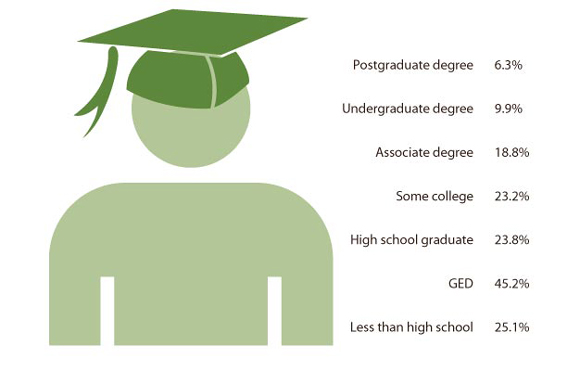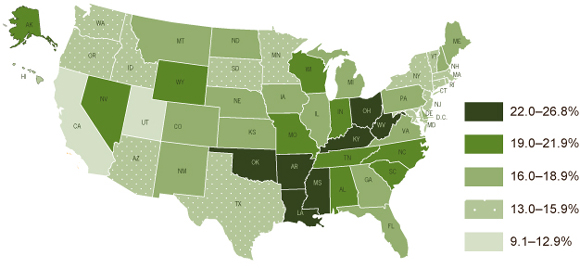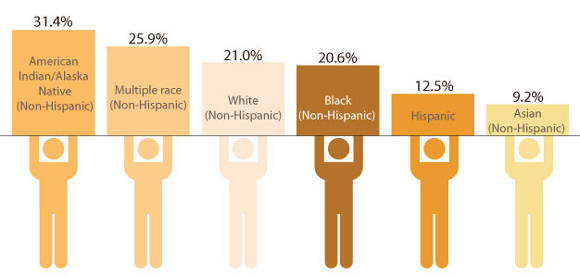Adult Smoking in the US
Vital Signs
September 2011



1 in 5
Nearly 1 in 5 adults (45.3 million) smokes. Among all adults, smoking declined from 20.9% in 2005 to 19.3% in 2010.

8%
Smokers are smoking less. Among adult daily smokers, the percentage who smoke 30 or more cigarettes per day dropped from 13% in 2005 to 8% in 2010.

50%
Half of adults who continue to smoke will die from smoking-related causes.
Tobacco use remains the single largest preventable cause of disease, disability, and death in the US. Some people who smoke every day are smoking fewer cigarettes; however, even occasional smoking causes harm. The percentage of American adults who smoke decreased from 20.9% in 2005 to 19.3% in 2010. That translates to 3 million fewer smokers than there would have been with no decline. But almost 1 in 5 adults still smoke. Reducing tobacco use is a winnable battle—a public health priority with known, effective actions for success. A combination of smoke-free laws, cigarette price increases, access to proven quitting treatments and services, and hard-hitting media campaigns reduces health care costs and saves lives.
443,000 Americans die of smoking or exposure to secondhand smoke each year.
Millions of people still smoke.
- For every smoking-related death, another 20 people suffer with a smoking-related disease.
- In 2010, 19.3% of adults (or 45.3 million) smoked cigarettes, compared with 20.9% of adults in 2005.
- Smoking costs the US about $96 billion each year in direct medical costs and $97 billion from productivity losses due to premature death.
There is no safe level of smoking.
- Each cigarette you smoke damages your lungs, your blood vessels, and cells throughout your body.
- Even occasional smoking is harmful, and the best option for any smoker is to quit completely.
- The more years you smoke, the more you damage your body. Quitting at any age has benefits.
- A majority of Americans who have ever smoked have already quit; you can too.
Why is it so hard to quit smoking?
- Nicotine is a highly addictive drug. Addiction keeps people smoking even when they want to quit.
- Cigarettes deliver more nicotine more quickly now than ever before.
- The tobacco industry spends about $9.94 billion each year, or $27 million every day, on cigarette advertising and promotion—72% of these dollars are spent on discounts to offset tobacco taxation and other tobacco control policies.
What’s the most effective way to quit smoking?
- Different ways work for different people. Many smokers have to try multiple times before they’re able to quit for good. It is important to keep trying until you succeed; each time you learn something that will help you quit for good.
- While you’re trying to quit, nicotine and non-nicotine containing medications can help lessen the urge to smoke. Talk to your health care provider for help.
- Individual, group, or telephone counseling can double your likelihood of success. A combination of medication and counseling is more effective than medication or counseling alone.
- Smokers can receive free resources and assistance to help them quit by calling 1-800-QUIT-NOW (1-800-784-8669) or visiting www.smokefree.gov.
The more states invest in comprehensive tobacco control programs, the greater the reductions in smoking—and the longer they invest, the greater and faster the impact.
- California’s adult smoking rate has dropped nearly 50% and the number of cigarettes smoked per person has decreased by 67% since the state began the nation’s longest-running tobacco control program in 1988.
- California saved $86 billion in health care costs by spending $1.8 billion on tobacco control, a 50:1 return on investment over its first 15 years of funding its tobacco control program.
US Adult Smoking Statistics
SOURCE: National Health Interview Survey, 2010
Percent of adults who smoke by sex

Percent of adults who smoke by education level

Education estimates are among individuals ≥ 25 years of age.
Adult Smoking Prevalence by State

SOURCE: Behavioral Risk Factor Surveillance System, 2010
Tobacco users can
- Quit. The sooner you quit, the sooner your body can begin to heal, and the less likely you are to get sick from tobacco use.
- Ask a health care provider for help quitting and call 1-800-QUIT-NOW for free assistance.
- Find a step-by-step quit guide at www.smokefree.gov.
State and community leaders can
- Fund comprehensive tobacco control programs at CDC-recommended levels.
- Enact 100% smoke-free indoor air policies that include workplaces, restaurants, and bars.
- Increase the price of all tobacco products.
- Implement hard-hitting media campaigns that raise public awareness of the dangers of tobacco use and secondhand smoke exposure.
- Use the World Health Organization’s (WHO’s)
MPOWER strategies to prevent and reduce tobacco use and to make tobacco products less accessible, affordable, attractive, and accepted.
M=Monitor tobacco use and prevention policies
P=Protect people from tobacco smoke
O=Offer help to quit
W=Warn about the dangers of tobacco use
E=Enforce restrictions on tobacco advertising
R= Raise taxes on tobacco
Parents and nonsmokers can
- Make your home and vehicles smoke-free.
- Not start, if you aren’t already using tobacco.
- Quit if you smoke; children of parents who smoke are twice as likely to become smokers.
- Teach children about the health risks of smoking and secondhand smoke.
- Encourage friends, family, and coworkers to quit.
Health care providers can
- Ask their patients if they use tobacco; if they do, help them quit.
- Refer patients interested in quitting to 1-800-QUIT-NOW, www.smokefree.gov, or other resources.
- Advise all patients to make their homes and vehicles 100% smoke-free.
- Advise nonsmokers to avoid secondhand smoke exposure.
Employers can
- Establish a policy banning the use of any tobacco product indoors or outdoors on company property by anyone at any time.
- Provide all employees and their dependents with health insurance that covers support for quitting with little or no co-payment.
Retailers can
- Learn the new Food and Drug Administration (FDA) restrictions on youth access to tobacco products and tobacco marketing to youth, and closely follow them.
- Never sell any tobacco product to customers younger than 18 years of age (or 19 in states with a higher minimum age requirement).
- Check the photo ID of any customer trying to buy tobacco products who appears to be 26 years of age or younger.
- Vital Signs Issue details: Morbidity and Mortality Weekly Report (MMWR)
- CDC Feature – CDC Reports Vital Information on Smoking
- Vital Minute Podcast: The Tobacco Use Epidemic – What You Need to Know (English) [1:17 minutes]
- Vital Minute Podcast: The Tobacco Use Epidemic – What You Need to Know (Spanish) [0:60 seconds]
- Vital Minute PSA: The Tobacco Use Epidemic – What You Need to Know (English) [0:60 seconds]
- Winnable Battles


